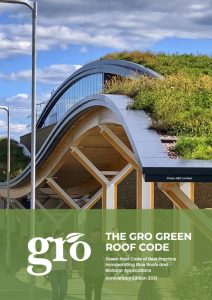Green roofs are a ‘must have’ among architects, homeowners, commercial developers and office owners looking to improve the environment or simply tick the sustainability box on their planning proposals. It is one of the This becomes even more important with the introduction of legal requirements for Biodiversity Net Gain (BNG) from this month for all but small sites.
The market for green roofs has expanded at a real pace over the past two decades, with the emergence of experts and dedicated groups of professionals, but the process of selecting, installing and maintaining green, brown (biodiverse) roofs is difficult. There’s still a lot of misinformation out there about the best way to do it. ) or blue roof.
This is why GRO (Green Roof Organization), the trade body for the UK green roof industry, has developed a code of practice that clearly defines what is required when planning, designing and creating a green roof. This guide, known as the GRO Green Roof Code, was originally published in 2011, and his updated 10th anniversary edition (known as the GRO Code of Best Practice) was published in 2021.
What does the GRO Green Roof Code advise?
While this guide covers the entire process of selecting, designing, installing and maintaining a green roof, the absolutely key element of the code is the minimum standard of 60mm of substrate over a sedum blanket. This is crucial for the sustainability of green roofs. Too many green roof projects fail because the substrate depth is too shallow. Substrate levels allow for weather-tolerant plantings, especially when summer droughts stress roofs.
Green roof failures due to substrate depth are often caused by pressure on specifications. Often this is done as a result of ignorance and is pursued by the trend towards lighter roofs. Although the structural integrity of the actual roof frame is not an issue for almost all green roof specifications, height and weight concerns still adjust the underlying specification, resulting in impact on long-term sustainability. . In London, where there is a special policy on green roofs, the substrate thickness is almost always around 80 mm, but outside of London this is not always the case.
Designing roofs according to the guidelines of the GRO Green Roof Code, and specifically requiring that the guide be followed, will help increase the importance of well-designed green roofs and reduce the risk of specification violations.
Guidance on definitive best practices for green roofs
 The GRO Code of Practice is based on the German FLL Guidelines for Green Rooftops, which were introduced in 1984 and first published in English in 2002. The FLL Guidelines are considered the definitive best practice guide for the design, planning and installation of green roofs around the world.
The GRO Code of Practice is based on the German FLL Guidelines for Green Rooftops, which were introduced in 1984 and first published in English in 2002. The FLL Guidelines are considered the definitive best practice guide for the design, planning and installation of green roofs around the world.
The GRO Code of Practice fully explains how green roof contractors can work with architects, roofing contractors and builders to establish sustainable green roofs. It clearly defines the benefits of deeper substrates and recommends contractual responsibilities for planting and maintenance, ensuring that complex, living building systems have the best potential for preforming for decades to come. It will help you maintain it.
Green Roof Code 2021 is the first major update since 2014. It includes definitions, specifications, and guidelines for:
- Blue roof, roof incorporating sustainable drainage system (SuDS)
- Biosolar roof – green roof with solar panels
- Biodiversity Net Gain (BNG).
The new GRO Code promotes best practices and is important for everyone up and down the supply chain to understand and follow. Green roofs are not just a trend. It’s environmentally friendly, it’s attractive, and it’s here to stay. By applying good practice standards, it can also be sustainable.
Eco green roof and GRO code
We asked Steven Vincent of Eco Green Roofs about the GRO Green Roof Code. He said,
“GRO sets standards for root zone depth based on the German FLL Green Roof Guide. You can grow grass on the edge of a muddy puddle, but it won’t last long. It’s not sustainable.
Different plants require different root zones to grow, so for a biodiverse roof (which may consist of sedums, grasses, and wildflowers), 80 mm to 150 mm This is why you may see specifications for dog runs and fills.
Sedum has been tested around the world in different climates and conditions and 80mm has been found to be optimal. This means that using 30, 40, or 50mm will damage your sedum over time. If you use 100mm, there is no additional benefit you get over 80mm as long as you use a free drain reservoir board like the EGR DBR20. When using “one-way” boards (those that are only drainage or only reservoir), it is expected that the substrate zone will be increased sufficiently (usually by an additional 40-50 mm) so as not to harm the plants.
Biodiversity-friendly roofs should have contours that give deeper-rooted species a chance to “acquire” and survive. ”

